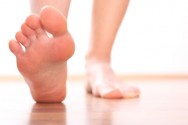 According to a study conducted at the University of Nevada and presented in the American Society of Biomechanics, when the foot hits in the ground while wearing rebound shoes, there is a 15% increase in force compared to a 96% increase when wearing standard running shoes. Rebound shoes, or boots with springs, are being used as a new trendy exercise with claims of reducing the intensity between the foot and the ground when jumping or running. Although more studies have found that the shoes reduce injuries, they have been known to cause an increase blisters on the feet.
According to a study conducted at the University of Nevada and presented in the American Society of Biomechanics, when the foot hits in the ground while wearing rebound shoes, there is a 15% increase in force compared to a 96% increase when wearing standard running shoes. Rebound shoes, or boots with springs, are being used as a new trendy exercise with claims of reducing the intensity between the foot and the ground when jumping or running. Although more studies have found that the shoes reduce injuries, they have been known to cause an increase blisters on the feet.
Exercise efficiency involves biomechanics, which incorporates the moving parts that manage the movement of your feet. To learn more about biomechanics, see Dr. Michael E. Newman from Pennsylvania. Our doctor can provide you with the foot and ankle information you seek.
A History of Biomechanics
- Biomechanics dates back to the BC era in Egypt where evidence of professional foot care has been recorded.
- In 1974 biomechanics gained a higher profile from the studies of Merton Root, who claimed that by changing or controlling the forces between the ankle and the foot, corrections or conditions could be implemented to gain strength and coordination to the area.
Modern technology improvements are based on past theories and therapeutic processes providing a better understanding of podiatry concepts for biomechanics. Computers provide accurate determinations about the forces, moments and patterns of the foot and lower legs with the most important information captured.
Advances in materials and more awareness of biomechanics have developed enhanced corrective methods, offering further options for foot-related injuries. Understanding foot biomechanics can help improve and eliminate pain, stopping further stress to the foot.
If you have any questions, please contact our offices located in Plymouth Meeting and Ambler, PA. We offer the newest diagnostic and treatment technologies for all your foot care needs.
